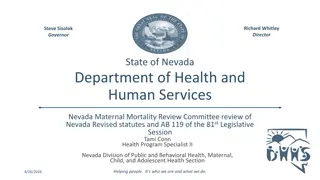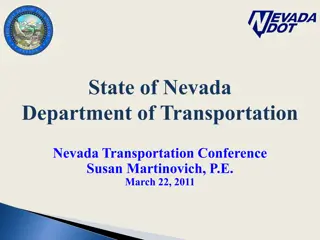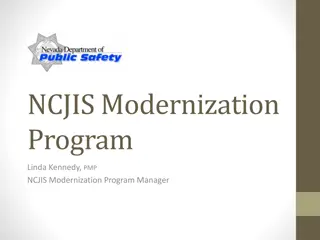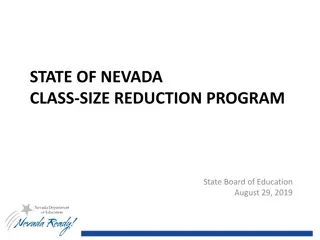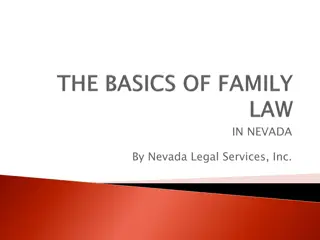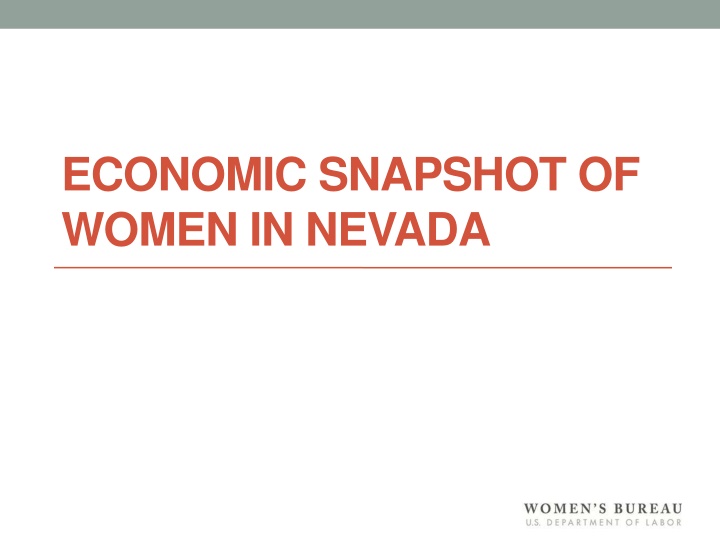
Economic Snapshot of Women in Nevada: Demographics, Workforce, and Minimum Wage
Explore the economic snapshot of women in Nevada, covering demographic statistics, race and ethnicity breakdown, workforce characteristics, and the impact of minimum wage on women in the state. Gain insights into the proportion of women in the total population, their workforce participation, wage gaps, and more.
Download Presentation

Please find below an Image/Link to download the presentation.
The content on the website is provided AS IS for your information and personal use only. It may not be sold, licensed, or shared on other websites without obtaining consent from the author. If you encounter any issues during the download, it is possible that the publisher has removed the file from their server.
You are allowed to download the files provided on this website for personal or commercial use, subject to the condition that they are used lawfully. All files are the property of their respective owners.
The content on the website is provided AS IS for your information and personal use only. It may not be sold, licensed, or shared on other websites without obtaining consent from the author.
E N D
Presentation Transcript
ECONOMIC SNAPSHOT OF WOMEN IN NEVADA
Topics Demographic Statistics Race and ethnicity Foreign born Total population Workforce Characteristics Women and the minimum wage Women, families, and poverty Economic Status of Nevada Women Gender wage gap over time Gender wage gap by Congressional district Earnings by educational attainment Occupational distribution Median earnings by occupation Unemployment rate Median earnings by race/ethnicity Nevada industries Small business profile Status of Paid Leave and Childcare in Nevada
DEMOGRAPHIC STATISTICS
Demographic Statistics Total Population: 2,890,845 Number of women and girls, All Ages: 1,442,531 (49.9% of total population) Proportion of Women Aged 65 and Older: 15.4% Proportion of Women Who Are Immigrants, All Ages: 20.4% Percent of Households Headed by Single Mothers with Children Under Age 18: 7.2% Foreign born in Nevada 558,170 Source: U.S. Census Bureau, Selected Population Profile in the United States, 2015 American Community Survey, 1-Year Estimates
Race and Ethnicity White Black or African American 28% 51% American Indian and Alaska Native Asian 1% Native Hawaiian and Other Pacific Islander Hispanic or Latino 9% 9% 2% Source: U.S. Census Bureau, Selected Population Profile in the United States, 2015 American Community Survey, 1-Year Estimates
WORKFORCE CHARACTERISTICS
Workforce Characteristics 58.2% of all Nevada women participating in labor force. 7.7% unemployment rate for women in Nevada 42.7% of working women worked full-time, year round Women earned 84% of the men s wages wage gap was greater for women of color The poverty rate of families with a single female householder with children under 5 was 35.2% Median annual earnings for women working full-time, year- round: $36,565 Source: U.S. Census Bureau, 2015 American Community Survey 1-Year Estimates, Nevada
Women and the Minimum Wage The federal minimum wage has been stuck at $7.25 an hour for 7 years. Nevada minimum wage is at $8.25; $7.25 for employees offered health benefits by employer. 1 According to Oxfam America, Women represent nearly 2/3rds of minimum wage workers across the country and in Nevada, they represent more than half of all minimum wage workers. 2 In Nevada, 30.3% of all workers earn less than $12 an hour (Oxfam America). Nearly half of Nevada minimum wage workers have no paid sick leave (49%) (Oxfam America). 1. 2. National Women s Law Center Oxfam America, Economic Policy Institute
Oxfam Study Finds Women are the Majority of Low-Wage Workers
Women and Families Profile Married Couple Families Male householder, no wife present Female householder, no husband present 10% 21% 21% 69% Of the 21 percent of households headed by women, 54 percent have children under the age of 18 living in their homes and 9 percent have children under the age of 6. Source: U.S. Census Bureau, 2015 American Community Survey 1-Year Estimates, Nevada
Families headed by Women Raising Children by Age of Children 11 percent of families live below the poverty line 51 percent are headed by women. Under 5 years only, 13% Of those households headed by women, 84 percent have related children under the age of 18. Under 5 years and 5 to 17 years, 27% 5 to 17 years only, 60% Among these families, 60 percent are public school age, 13 percent are newborn to preschool age, and 27 percent are a mix between the two.
ECONOMIC STATUS OF WOMEN IN NEVADA
AAUW Gender Wage Gap by Nevada Congressional District Source: American Association of University Women
Median Earnings by Educational Attainment and Sex, 2015 $80,000 $75,043 $70,000 $60,000 $55,266 $51,898 $50,000 $40,217 $40,010 $40,000 $32,257 $30,389 $27,209 $30,000 $26,105 $20,945 $20,000 $10,000 $- Less than high school graduate High school graduate (includes equivalency) Some college or associate's degree Bachelor's degree Graduate or professional degree Men Women Source: U.S. Census Bureau, 2015 American Community Survey 1-Year Estimates, Nevada
Nevada Mens and Womens Occupational Distribution, 2015 Production, transportation, and material moving 4% Women Men Computer, engineering, and science 2% Computer, engineering, and science 5% Healthcare practitioner and technical 7% Healthcare practitioner and technical 3% Management, business, and financial 15% Production, transportation, and material moving 15% Management, business, and financial 14% Service 24% Sales and office 36% Service 25% Sales and office 18% Education, legal, community service, arts, and media 10% Natural resources, construction, and maintenance 16% Education, legal, community service, arts, and media 5% Natural resources, construction, and maintenance 1% Source: U.S. Census Bureau, 2015 American Community Survey 1-Year Estimates, Nevada
Median Earnings by Occupational Categories and Sex, 2015 $80,000 $74,486 $70,782 $70,000 $67,414 $65,883 $61,507 $60,000 $54,836 $52,197 $48,727 $50,000 $44,422 $40,084 $40,000 $37,221 $35,076 $34,365 $32,348 $30,726 $30,000 $27,190 $20,000 $10,000 $- Management, business, and financial Computer, engineering, and science Education, legal, community service, arts, and media Healthcare practitioner and technical Service Sales and office Natural resources, construction, and maintenance Production, transportation, and material moving Men Women Source: U.S. Census Bureau, 2015 American Community Survey 1-Year Estimates, Nevada
Unemployment Rate, 2016 7 6.5 6.5 6.4 6.3 6.2 6.1 6 5.9 5.8 5.8 5.8 US NV 5.5 5 5 5 5 4.9 4.9 4.9 4.9 4.9 4.7 4.5 4 Jan Feb Mar Apr May Jun Jul Aug Sept Source: U.S. Bureau of Labor Statistics.
Unemployment Rate for Nevada Men and Women, 2015 7.8% 7.7% 7.6% 7.6% 7.4% Men Women Source: U.S. Census Bureau, 2015 American Community Survey 1-Year Estimates, Nevada
Median Earnings by Race/Ethnicity and Sex, 2015 $60,000 $52,267 $50,000 $43,681 $41,706 $41,528 $37,994 $40,000 $36,565 $35,748 $35,573 $32,482 $30,365 $30,000 $20,000 $10,000 $- Total Black Asian White, Not Hispanic or Latino Hispanic or Latino Men Women Source: U.S. Census Bureau, 2015 American Community Survey 1-Year Estimates, Nevada
Nevadas Largest Industries & Employers Industries Major Employers Tourism and Gaming Logistics Manufacturing Mining Aerospace & Defense Agriculture Energy Health Care Information Technology Wynn Las Vegas LLC Venetian Resort Hotel & Casino Las Vegas Sands Corp US Air Force Base Liberty Tax Services Source: Nevada Governor s Office of Economic Development
Companies Doing Business in Nevada Source: Nevada Governor s Office of Economic Development
STATUS OF PAID LEAVE AND CHILD CARE IN US AND NEVADA
What do we know about family leave on a national level? US is the only industrialized nation without a national paid leave program 12.6 percent of private-sector employees took family and medical leave in 2012 while 4.5 percent had unmet leave needs 1 in 4 employees needing leave had their leave needs unmet in the past 12 months because: 49.6 percent could not afford unpaid leave 18.3 percent feared losing their job as a result of taking leave.3 3. Jorgensen, H. Appelbaum, E.
Employees with children living at home and female employees had the greatest need for leave and highest rates of unmet leave. In March 2016, 13 percent of all private sector workers had access to paid leave.4 7 percent of service workers had access to leave and 13 percent of those who had leave are in the sales and office industry (BLS) 4. Bureau of Labor Statistics
What do we know about family leave in Nevada? Nevada does not significantly expand upon federal law for state employees or private-sector workers. 49 percent of workers do not have access to paid sick days according to a study by the National Partnership for Women and families and the Institute for Women s Policy and Research, a higher rate than the national average of 12.5 percent.5 37 percent of workers work for an employer with less than 50 employees.6 Lack of data available to indicate the number of Nevada employees, specifically women who are covered under FMLA 5. 6. National Partnership for Women and Families U.S. Census Bureau, American Community Survey, 2014
What do we know about childcare in Nevada? Parents working full-time, child care costs would be 37% of household income Cost of childcare is high and even more than in-state college tuition $27,147 for in-home and $9,724 for in-center 7 Infant care costs as a share of minimum wage earnings is 57.4% $9,852 for annual infant care costs 8 7. 8. New America Economic Policy Institute
Infant care costs as a share of public college tuition Is 195.9% Average in-state tuition for 4-year public college is $5,029 (i.e. UNLV is $5,760) Nevada has 221,494 children under age 6, 65 percent of whom have working parents9 Child Care and Development Block Grant (CCDBG) serves only 6 percent of federally eligible children in Nevada10 9. 10. Center for American Progress U.S. Census Bureau






